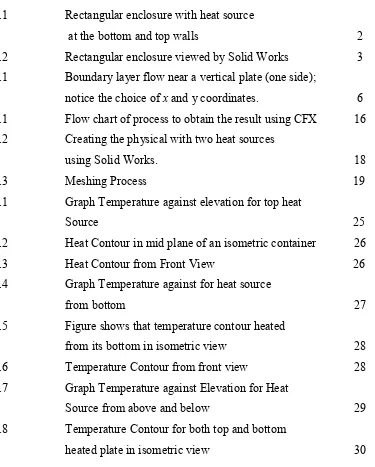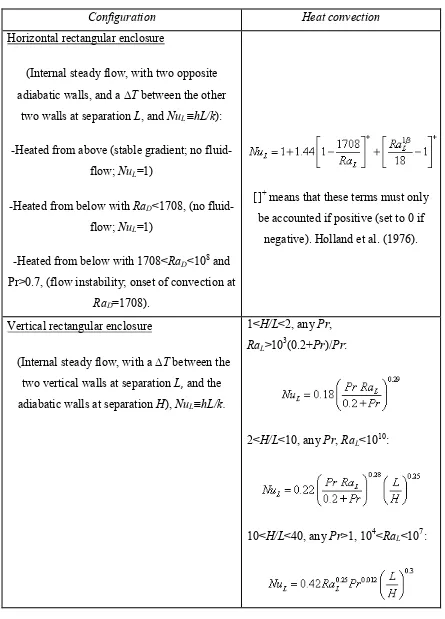LAMINAR NATURAL CONVECTION IN ENCLOSURE CONTAINING FLUID
AIDIL AZLAN BIN AHMAD ZAMRI
‘Saya/Kami* akui bahawa telah membaca karya ini dan pada pandangan saya/kami* karya ini
adalah memadai dari segi skop dan kualiti untuk tujuan penganugerahan Ijazah Sarjana Muda Kejuruteraan Mekanikal (Termal-Bendalir)’
Tandatangan :……….. Nama Penyelia I:……….. Tarikh :……….
i
“Saya akui laporan ini adalah hasil kerja saya sendiri kecuali ringkasan dan petikan yang tiap-tiap satunya saya telah jelaskan sumbernya”
Tandatangan: ……….. Nama Penulis : ……….
iii
ACKNOWLEDGEMENT
Alhamdulillah with His Mercy and Blessings, my greatest attitude to Allah the Almighty for the chances given to me to complete this project. My first acknowledgement goes to Mr. Shamsul Bahari bin Azraai, my project supervisor. Thanks for his tremendous help, advice, inspiration and unending guidance to me until completing this thesis. Without him, this project will not exist. The fundamental idea behind this project is his and he never stop from giving me support and encouragement in completing this project. Without his valuable guidance, I would not have been able to achieve the objectivity of this project.
Not forgotten to my beloved family especially my parents, Ahmad Zamri Bin Mohd Bak and Maimunah Bte Ibrahim. Your love and caring are really touch me. Thank you so much for giving me lifelong encouragement, inspiration, bravery, financial and also moral support. Last but not least, to my best friend, Nurul Akma Binti Mahpot that always there to give all the supports and ideas to complete this project. Hope that they get the best in life.
ABSTRACT
v
ABSTRAK
CONTENTS
CHAPTER TITLE PAGE
PENGAKUAN i
DEDIKASI ii
ACKNOWLEDGEMENT iii
ABSTRACT iv
CHAPTER II LITERATURE RIVIEW
2.1 Introduction 4
vii
CHAPTER TITLE PAGE
Rectangular Enclosure in
Natural Convection 6
2.3 Computational Fluid Dynamics 8
2.4 ANSYS-CFX 9
2.5 Previous Studies 9
CHAPTER III METHODOLOGY
3.1 Introduction 14
3.2 Computational Fluid Dynamics 16
3.2.1 ANSYS-CFX 16
3.2.1.1 Geometry/Mesh 16
3.2.2 ANSYS CFX-Solver 18
3.2.2.1 Physics Definition 19
3.2.2.2 Solver 19
3.2.3 ANSYS CFX-Post 20
3.2.3.1 Post-processor 20
CHAPTER IV RESULTS AND DISCUSSION
(Both Heated) 28
4.2.1.2 Velocity Contour 30 4.2.1.2.1 Case One
CHAPTER V CONCLUSION AND RECOMMENDATION 36
REFERENCES 37
BIBLIOGRAPHY 40
ix
LIST OF FIGURES
FIGURE NO. TITLE PAGE NUMBER
1.1 Rectangular enclosure with heat source
at the bottom and top walls 2
1.2 Rectangular enclosure viewed by Solid Works 3 2.1 Boundary layer flow near a vertical plate (one side);
notice the choice of x and y coordinates. 6 3.1 Flow chart of process to obtain the result using CFX 16 3.2 Creating the physical with two heat sources
using Solid Works. 18
3.3 Meshing Process 19
4.1 Graph Temperature against elevation for top heat
Source 25
4.2 Heat Contour in mid plane of an isometric container 26
4.3 Heat Contour from Front View 26
4.4 Graph Temperature against for heat source
from bottom 27
4.5 Figure shows that temperature contour heated
from its bottom in isometric view 28
4.6 Temperature Contour from front view 28
4.7 Graph Temperature against Elevation for Heat
Source from above and below 29
4.8 Temperature Contour for both top and bottom
4.9 Figure of heat contour front view 30
4.10 Velocity Contour For case one 31
4.11 Velocity Contour For case two 32
4.12 Velocity Contour for Case Three 33
4.13 Velocity Vector for Case One 34
4.14 Velocity vector for case Two from Front view 35
xi
LIST OF TABLES
TABLE NO. TITLE PAGE NUMBER
2.1 Convective Heat Correlation for Natural 7
LIST OF SYMBOLS
xiii
LIST OF ABBREVIATIONS
CFD = Computational fluids dynamics
CHAPTER I
INTRODUCTION
1.1 Overview
Free convection in enclosure has attracted many researcher and also interest of investigators. Various applications in this term that really attractive such as electronic devices, furnaces, power plant and heat transfer through pipes. This result is relevant due to environmental science, where the heat transfer take part of responsibility for oceanic and atmosphere motion.
Free convection fluid motion is due to buoyancy forces within the fluid. Now we consider situation which there is no forced velocity, yet convection current exit within the fluid. Such situation is referred as free or natural convection, and they originate when a body force act on a fluid in which there are density gradients. The net effect is a buoyancy force, which induced free convection currents. In the most common case, the density gradient is due to a temperature gradient, and the body force is due to the gravitational field.
2 transfer rates or to minimize operating cost, free convection is often preferred to forced convection.
1.2 Problem Statement
Problems occurred when there is a rectangular enclosure container with heat source at the top and bottom walls shown in figure 1.1 that heat source from supply from bottom and top of the enclosure. The heat source are then heated into a certain temperature so that’s the fluid within the container shall have a convection condition. So, a software is use to obtain the result (heat flow). The software is important due to simulate the heat flow in order to see which part will be in high temperature and how does the heat moves. Eventually, from this problem, another problem can be issued, whereas in case of partition or without any partition. Figure 1.2 shows the container form in three-dimensional or in isometric view.
Figure 1.2: Rectangular enclosure viewed by Solid Works.
1.3 Objective
To predict numerically the heat distribution in an enclosure container with top and bottom heat source.
1.3 Scope
4
CHAPTER II
LITERATURE REVIEW
2.1 Introduction
Natural convection is the fluid flow originated by gravity forces acting on non-uniform-density fluids; the density changes may be due to thermal or to solutal gradients. Many different natural-convection configurations are of interest, from the simplest hot or cold vertical plate in a fluid medium, to external convection around hot or cold bodies, or internal convection within hot/cold enclosures (non-isothermal).
Laminar flow, sometimes known as streamline flow, occurs when a fluid flows in parallel layers, with no disruption between the layers. In fluid dynamics, laminar flow is a flow regime characterized by high momentum diffusion, low momentum convection, pressure and velocity independent from time. It is the opposite of turbulent flow.
The boundary layer on a hot vertical plate is a canonical thermo-fluid-mechanics problem. A semi-infinite vertical wall is shown in Fig. 2.1 (it must extend upwards if it is hot, or downwards if it is cold), maintained at constant temperature, Tw, and immersed
in a dilatable fluid (with thermal expansion coefficient ), at temperature T∞ far from the
and finally decreasing to u=0 at the outer edge of the layer the outer fluid is at rest except for the very small entrainment flow implied by the boundary layer growth.
Figure 2.1: Boundary layer flow near a vertical plate (one side); notice the choice of x
and y coordinates.
The terms governing the flow near the vertical plate, assumed steady and incompressible except for the momentum buoyancy term (Boussinesq model), are the following;
I. Mass balance (continuity):
6 II. Momentum Balance
The law of conservation of momentum is a fundamental law of nature, and it states that the total momentum of a closed system of objects (which has no interactions with external agents) is constant. In short when an object had a collision with another object, the momentum for both of them are the same.
III. Energy Balance
Conservation of energy states that the total amount of energy in any system remains constant, although it may change forms for example friction turns kinetic energy into thermal energy. Meaning that energy cannot be created or destroy but can be changed from one to another.
Fluids are also the main part of the convection movement. There is a great variety of heating fluids and cooling fluids, which can be grouped basically as gases, liquids, and phase-changing fluids.
2.2 Empirical Correlation for Rectangular Enclosure in Natural Convection
Configuration Heat convection
Horizontal rectangular enclosure
(Internal steady flow, with two opposite adiabatic walls, and a T between the other
two walls at separation L, and NuL≡hL/k):
-Heated from above (stable gradient; no fluid-flow; NuL=1)
-Heated from below with RaD<1708, (no
fluid-flow; NuL=1)
-Heated from below with 1708<RaD<108 and
Pr>0.7, (flow instability; onset of convection at
RaD=1708).
[]+ means that these terms must only
be accounted if positive (set to 0 if negative). Holland et al. (1976).
Vertical rectangular enclosure
(Internal steady flow, with a T between the two vertical walls at separation L, and the adiabatic walls at separation H), NuL≡hL/k.
1<H/L<2, any Pr,
RaL>103(0.2+Pr)/Pr:
2<H/L<10, any Pr, RaL<1010:
10<H/L<40, any Pr>1, 104<Ra
8
Inclined rectangular enclosure
(Internal steady flow, with a T between the two closest walls at separation L, tilted an angle from the vertical, and the adiabatic
walls at separation H), NuL≡hL/k.
Fluid flow changes beyond a critical angle
cr(H/L):
2.4 ANSYS-CFX
CFX is a commercial CFD program used to simulate fluid flow in a wide variety of applications. CFX allows engineers to test systems in a virtual environment. It has been applied to the simulation of water flowing past ship hulls, gas turbine engines (including the compressors, combustion chamber, turbines and afterburners), aircraft aerodynamics, pumps, fans, HVAC systems, mixing vessels, hydrocyclones, vacuum cleaners, and more. Pretty much anything that involves fluid flow can be simulated, if you have the expertise and computing power. Regarding computing power, CFX can give any cluster a run for its money. It is highly scalable and has been shown to maintain nearly linear scalability to as many as 500 processors.
2.5 Previous Studies
Natural convection in enclosures has attracted many of researchers in the world. The main ideas of heat transfer made a role to lead the research success. Through all applications such as furnace design, buildings, cooling of electronic equipment, nuclear reactor and others refer and studied on heat transfer buoyant flow in enclosures.
Results that come out are studied either by numerically or experimentally or even both. Generally, studies about convective in enclosures without partition convinced by Elder (1965a, b, 1966). Then, later results presented by Catton (1978) and Yang (1987), Ostrach (1972, 1982).

